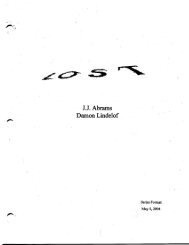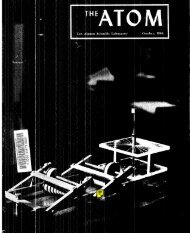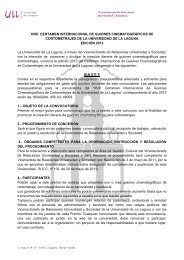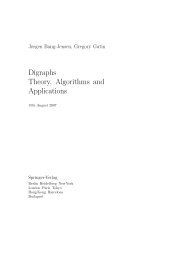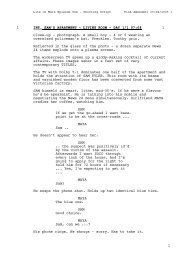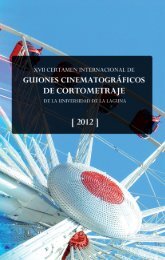Create successful ePaper yourself
Turn your PDF publications into a flip-book with our unique Google optimized e-Paper software.
Throuuh thg decimal poiltt<br />
Where the quadratic x2 - x has four roots<br />
by A. B. Zhiglevich and N. N. Petrovl<br />
a<br />
:l-'<br />
---<br />
:.:==<br />
:=:t:<br />
=.-=:<br />
=<br />
=o<br />
-u<br />
g)<br />
o<br />
a'\<br />
f<br />
o<br />
f<br />
C<br />
(n<br />
x<br />
E WILL TRY TO PERSUADE YOU THAT THE<br />
number of roots of the ecluationx2 = x is not two/<br />
as everybody thinks, but four, as stated in the<br />
title of this article. But first we offer the following<br />
undisputed fact. If a natural number (in decimal notation)<br />
ends in any of the digits 0, l, 5, or 5, its square<br />
ends in the same digit. This also applies to the two-digit<br />
endings 00, 01, 25, and75-thatis, if a number ends in<br />
one of these pairs of digits, its square does too (for instance,<br />
17 62 = 30,97 6j 2252 = 50,625 ; and so on). A similar<br />
property holds for the three-digit endings 000, 001,<br />
625, and376. At the same time, no other one-, two-, and<br />
three- digit endings possess this property. What's so<br />
special about these combinations of numbers? The<br />
answer is given by the following theorem.<br />
THroRru. For any natural k there are exactly four<br />
sets of k digits (00. . .00, 00 . . .01, and two more, ending<br />
in 5 and 6, respectively) such that if a natural number<br />
ends in one of these sets of digits, the square of this<br />
number ends in the same set of digits.<br />
To eliminate any doubts, we'llgive two proofs of this<br />
theorem. But first let's try to understand better what<br />
we have to prove.<br />
We're looking for an integer & 0 < x < 10&, such that<br />
for any integer a > O the square of the number 10&a + x<br />
(which is the general form of a number whose k-digtt<br />
ending coincides with x) has the form 10kb + x, where b<br />
is an integer. But (108a + xlz = tCf(tOka2 + 2axl + x2, so<br />
our condition simply amounts to the fact that x2 - x is<br />
divisible by 1S. Thus we've arrived at a very simple problem:<br />
to find all integers x, 0 < x < 1#, such that x2 - x is<br />
divisible by 1S. We must make sure that this probiem<br />
has four solutions, and that these solutions have the properties<br />
specified in the theorem.<br />
First proof . The difference * - x = x(x - 1) must be<br />
divisible by 10k : 2k5k. But the numbers x and x - 1<br />
lSome material by V. Denisenko was incorporated in<br />
this article with his permission.-Ed.<br />
can't both be divisible by 2 arrd can't both be divisible<br />
by 5. So we're left with four possibilities:<br />
(1) x is divisible by 10ft;<br />
(21 x - 1 is divisible by 10ft;<br />
(3) x is divisible by 2k andx - 1 is divisible by 5k;<br />
(4) x is divisible by 5k and x - I is divisible by 2k.<br />
Since x < 10&, the {irst possibility can occur only i{ x = 0;<br />
similarly, the second possibility corresponds to x = 1.<br />
Lr case (3 ) the numberx (and in case (4) the numberx - 1 )<br />
isoneof thenumbers a.2k, andsince x>x- 1>5k,<br />
we know that 0 < a < 5k - 1. All these numbers yield<br />
different remainders when dividedby 5k, because if the<br />
numbers Zkb and2kc give the same remainders upon<br />
division by 5k, then their difference 2k(c - b) is divisible<br />
by 5k, and so by 10k as well, which is impossible<br />
< 5k. But there are only 5k possible remain-<br />
for 0 < c -b<br />
ders, so each of them is represented once among our<br />
numbers 2ka. This means that exactly one of these<br />
numbers-say,Zkar-'has the remainder l, so that for<br />
x = Zkav the numberx - I is divisible by 5ft. Similarly,<br />
exactly one of these numbers-say, Zkar-has the remainder<br />
5k - 1 when divided by 5k, and-so, for x - I =<br />
2ka, the number x is divisible by 5k.<br />
This conclusively shows that in each of our four<br />
cases there is one and only one x satisfying our conditions,<br />
so the problem has exactly four solutions. It's<br />
also clear that in case (3) the number x ends in 6, and<br />
in case (4) it ends in 5. The proof is complete.<br />
Second proof . We'll take it for ganted that the problem<br />
has no more than four solutions. (We know this from<br />
the first proof, but it can be proved directly as we11.)Also,<br />
we'll use induction over k: we'll assume that we've already<br />
found the numbers xu_, and )27._ 1<br />
ending in 5 and<br />
6, respectively, such that 0 (xo_, . lG- I, 0 ( /r_ r<br />
. 1S-',<br />
and the differences x? _ t - xx _ , and yoz_ f yx _, are divisible<br />
by lgr- 1 (we create a basis for the inductionthat<br />
is, the existence of x, and yr- by setting xr = 5,<br />
0U[]tlIUil/rtlIltRt 17



